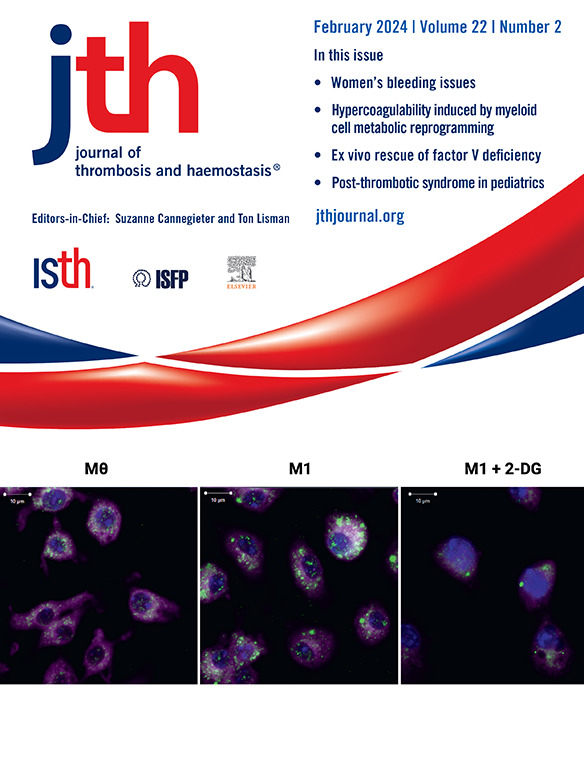Angiostatin - 一种新型 SARS-CoV-2 抑制剂和 COVID-19 病理生理学的生物标志物。
IF 5.5
2区 医学
Q1 HEMATOLOGY
引用次数: 0
摘要
背景:尽管有有效的疫苗,但由于免疫逃逸变异,许多人仍然面临COVID-19严重疾病和死亡的风险。因此,需要更好地了解COVID-19病理生理基础的生物标志物,以提高疾病进展预测和确定新的药物靶点。血管抑制素是一种由血小板产生的源自纤溶蛋白(原)的蛋白。作为COVID-19的一个关键病理特征,微血管血栓形成可产生高血管抑制素浓度和缺氧/酸中毒的微环境,这些条件有利于血管抑制素对内皮细胞和上皮细胞的促凋亡作用,血管抑制素可能是促进COVID-19病理生理的生物标志物。目的:探讨血管抑制素在COVID-19中的作用。方法:比较新冠肺炎患者与阴性对照组的血浆血管抑制素浓度,以及新冠肺炎患者血浆血管抑制素的时间变化。随后,机制细胞研究调查了血管抑制素及其中和对SARS-CoV-2感染和随后的细胞死亡的影响。结果:SARS-CoV-2感染后血浆血管抑制素浓度升高,且在COVID-19患者中持续升高21 ~ 28天。在严重COVID-19的酸性微环境中,凝块在7-8小时内产生的浓度的血管抑制素可促进细胞死亡。无论pH值如何,血管抑制素通过干扰刺突蛋白蛋白水解,减少了SARS-CoV-2多种变体进入细胞。选择性血管抑制素中和肽抑制血管抑制素诱导的细胞死亡,但不抑制血管抑制素减少感染的能力。结论:血管抑制素在COVID-19中具有双重作用,既可以预防感染,又可以促进细胞死亡。选择性血管抑制素中和肽可能是进一步在重症COVID-19模型中进行临床前评估的新疗法。本文章由计算机程序翻译,如有差异,请以英文原文为准。
Angiostatin—a novel SARS-CoV-2 inhibitor and biomarker underlying COVID-19 pathophysiology
Background
Despite efficacious vaccines, many individuals remain at risk of severe illness and death from COVID-19 due to immune-escape variants. Hence, a better understanding of biomarkers underlying COVID-19 pathophysiology is needed to improve disease progression prediction and identify new drug targets. Angiostatin is a plasmin(ogen)-derived protein generated by platelets. As microvascular thrombosis, a key pathologic feature of COVID-19, can create microenvironments of both high angiostatin concentration and hypoxia/acidosis, conditions known to favor angiostatin’s proapoptotic actions on endothelial and epithelial cells, angiostatin may be a biomarker contributing to COVID-19 pathophysiology.
Objectives
To assess the role of angiostatin in COVID-19.
Methods
Plasma angiostatin concentrations were compared between COVID-19 patients and COVID-19-negative controls, as were temporal changes in plasma angiostatin in COVID-19 patients. Subsequent mechanistic cellular studies investigated the effects of angiostatin and its neutralization on both SARS-CoV-2 infection and subsequent cell death.
Results
Plasma angiostatin concentrations increased following SARS-CoV-2 infection and remained elevated in COVID-19 patients for 21 to 28 days. Angiostatin at concentration that would be generated within a clot over 7 to 8 hours promoted cell death in acidic microenvironments characteristic of severe COVID-19. Irrespective of pH, angiostatin reduced SARS-CoV-2 cellular entry of multiple variants by interfering with spike protein proteolysis. Selective angiostatin-neutralizing peptides inhibited angiostatin-induced cell death, but not angiostatin’s ability to reduce infection.
Conclusion
Angiostatin has dual roles during COVID-19, both preventing infection and promoting cell death. Selective angiostatin-neutralizing peptides may be novel therapeutics for further preclinical evaluation in models of severe COVID-19.
求助全文
通过发布文献求助,成功后即可免费获取论文全文。
去求助
来源期刊
CiteScore
24.30
自引率
3.80%
发文量
321
审稿时长
1 months
期刊介绍:
The Journal of Thrombosis and Haemostasis (JTH) serves as the official journal of the International Society on Thrombosis and Haemostasis. It is dedicated to advancing science related to thrombosis, bleeding disorders, and vascular biology through the dissemination and exchange of information and ideas within the global research community.
Types of Publications:
The journal publishes a variety of content, including:
Original research reports
State-of-the-art reviews
Brief reports
Case reports
Invited commentaries on publications in the Journal
Forum articles
Correspondence
Announcements
Scope of Contributions:
Editors invite contributions from both fundamental and clinical domains. These include:
Basic manuscripts on blood coagulation and fibrinolysis
Studies on proteins and reactions related to thrombosis and haemostasis
Research on blood platelets and their interactions with other biological systems, such as the vessel wall, blood cells, and invading organisms
Clinical manuscripts covering various topics including venous thrombosis, arterial disease, hemophilia, bleeding disorders, and platelet diseases
Clinical manuscripts may encompass etiology, diagnostics, prognosis, prevention, and treatment strategies.

 求助内容:
求助内容: 应助结果提醒方式:
应助结果提醒方式:


